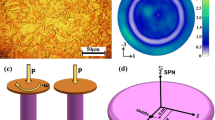Torsional deformation is regarded a promising deformation procedure to prepare the gradient structural materials. Pure copper was subjected to large plastic strains in torsion. Electron backscatter diffraction analysis was used to explore the microstructure evolution. The observations demonstrate that both high-angle grain boundaries and misorientation increase with strain. The grains finer and more homogeneous. In addition, the microstructure within the shear band demonstrates a distinct preferred orientation. The crystal <110> direction is parallel to the shear direction, and the crystal {111} inclines to the plane shear surface. A torsion-induced bar specimen includes a {011} <211> brass texture, {011} <100> Gaussian texture, and stronger {112} <111> copper texture.





Similar content being viewed by others
References
T. H. Fang, W. L. Li, N. R. Tao, and K. Lu, “Revealing extraordinary intrinsic tensile plasticity in gradient nano-grained copper,” Science, 331, No. 6024, 1587–1590 (2011).
J. Wang, D. Zhang, Y. Li, et al., “Effect of initial orientation on the microstructure and mechanical properties of textured AZ31 Mg alloy during torsion and annealing,” Mater. Design, 86, 526–535 (2015).
N. Guo, B. Song, H. Yu, et al., “Enhancing tensile strength of Cu by introducing gradient microstructures via a simple torsional deformation,” Mater. Design, 90, 545– 550 (2016).
C. Wang, F. G. Li, J. Li, et al., “Microstructure evolution, hardening and thermal behavior of commercially pure copper subjected to torsional deformation,” Mater. Sci. Eng. A, 598, 7–14 (2014).
J. H. Li, F. G. Li, M. Z. Hussain, et al., “Micro-structural evolution subjected to combined tension–torsional deformation for pure copper,” Mater. Sci. Eng. A, 610, 181–187 (2014).
B. Song, N. Guo, R. Xin, et al., “Strengthening and toughening of extruded magnesium alloy rods by combining pre-torsional deformation with subsequent annealing,” Mater. Sci. Eng. A, 650, 300–304 (2016).
C. P. Wang, F. G. Li, L. Wei, et al., “Experimental microindentation of pure copper subjected to severe plastic deformation by combined tension–torsion,” Mater. Sci. Eng. A, 571, 95–102 (2013).
A. Nadai, Theory of Flow and Fracture of Solids, McGraw-Hill, New York (1950).
J. Chakrabarty, Theory of Plasticity, Butterworth-Heinemann, Oxford (2006).
Y. Estrin, L. S. Tóth, A. Molinari, and Y. Bréchet, “A dislocation-based model for all hardening stages in large strain deformation,” Acta Mater., 46, No. 15, 5509–5522 (1998).
N. A. Fleck, H. M. Muller, M. F. Ashby, and J. W. Hutchinson, “Strain gradient plasticity: theory and experiment,” Acta Metall. Mater., 42, No. 2, 475–487 (1994).
A. Bhattacharyya, D. Rittel, and G. Ravichandran, “Effect of strain rate on deformation texture in OFHC copper,” Scripta Mater., 52, No. 7, 657–661 (2005).
S. Khamsuk, N. Park, H. Adachi, et al., “Evolution of ultrafine microstructures in commercial purity aluminum heavily deformed by torsion,” J. Mater. Sci., 47, No. 22, 7841–7847 (2012).
Acknowledgments
This work was partially supported by National Natural Science Foundation of China (No. 51275414, No. 51172161, No. 51405136, and No. 51505191), School Youth Foundation (No. 1205-04020202), the fund of the State Key Laboratory of Solidification Processing in NWPU (No. SKLSP201517), and Doctor Foundation of Henan Polytechnic University (No. B2015-37).
Author information
Authors and Affiliations
Additional information
Translated from Problemy Prochnosti, No. 1, pp. 106 – 111, January – February, 2018.
Rights and permissions
About this article
Cite this article
Wang, C.P., Fan, J.K., Li, F.G. et al. Electron Backscatter Diffraction Analysis of the Microstructure Fineness in Pure Copper Under Torsional Deformation. Strength Mater 50, 92–97 (2018). https://doi.org/10.1007/s11223-018-9946-0
Received:
Published:
Issue Date:
DOI: https://doi.org/10.1007/s11223-018-9946-0




